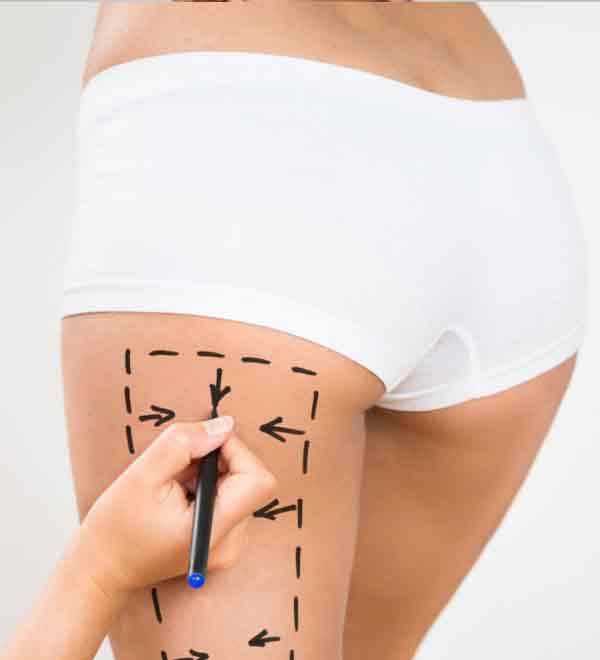
Physical exercises do not always solve the problem of localized fat, let alone excess skin on the inner thighs. Lipodystrophy and sagging thighs affect self-esteem and cause discomfort. In addition, the friction caused between the thighs can generate diaper rash and local skin changes.
Thigh plastic surgery ( thigh dermolipectomy, crural lifting, cruroplasty) aims to reshape the thighs, leaving them more toned and with smoother and more proportionate contours. However, it is always important to evaluate the cost-effectiveness of this surgery, as the patient will be exchanging sagging for scars in visible and apparent regions.
Plastic surgery of the thighs is part of post-slimming surgeries and can be associated with other procedures, such as: plastic surgery of the abdomen (abdominoplasty), reduction and lifting of the breasts (reduction mammoplasty or mastopexy), and plastic surgery of the arms.
According to the degree of involvement of the thighs, different procedures are proposed, with scars of varying sizes, which increase proportionally to the degree of sagging:
(1) Liposuction (without skin resection): indicated for young patients, with small accumulation of fat and absence or small flaccidity of the skin. The scars are imperceptible (0.5 cm each), only for the introduction of the liposuction cannula, in the crease of each groin, and there may be another on the medial side of each knee. Laser liposuction (lipolaser or laserlipolysis) is a good technique to eliminate sagging in some cases in which skin resection would already be indicated. In this procedure, the energy released towards the skin causes a greater retraction of this tissue, reducing the need for skin resection of the thighs.
(2) Conservative cruroplasty: indicated for patients with excess skin and fat on the thigh roots. The scars are horizontal and are hidden in the groin and inside the roots of the thighs.
(3) Conventional cruroplasty: indicated for patients who are older or who have suffered great weight loss (example: post-bariatric surgery), with a lot of excess skin and sagging on the inner side of the thighs. The scars are vertical along the inner side of the thighs and horizontal at the roots of the thighs (forming a “T”), extending from the groin to the inner side of the knees, with or without extensions to the sides of the pubis and the folds of the bottom of the glutes.
Surgical technique
- Bilateral marking of the area to be resected on the inner side of the thighs.
- Anesthesia + antisepsis.
- Removal of excess skin and fat from the inner thighs, with or without associated liposuction (the types and sizes of incisions depend on the amount and location of excess skin, however, the incisions, although visible, are positioned in the discrete – groin and/or medial thighs).
- Review of bleeding areas.
- Remodeling of the subcutaneous tissue + closure of operative wounds.
- Dressing + compression mesh.
- Observation: If there is only a need for fat reduction, without skin resection, the indicated surgery is liposuction.
Recovery
Recovery is usually fast, requiring relative rest and 14 days away from work. It is important to wear compression garments on the thighs for at least 60 days. During this same period, one should avoid: walking a lot, doing physical exercises or making sudden and wide movements with the thighs (measures that prevent the opening or enlargement of operative wounds). Purples and bumps are temporary and tend to go away gradually. Pain is rare. Sunbathing on scars is not allowed for at least 6 months.
COMMON QUESTIONS
Thigh plastic surgery: indication
Plastic surgery is indicated in ex-obese patients, with a lot of sagging and excess skin along the inner or medial region of the thighs, who have realistic expectations about the scars produced by the procedure.
From what age is thigh plastic surgery recommended?
Adults
What type of anesthesia is used for thigh lift surgery?
Site with sedation, spinal anesthesia with sedation, epidural with sedation or general.
How long does the surgery take?
Two to three hours.
What is the length of stay?
Hospitalization of eight to twelve hours. The patient is released the same day.
When can stitches be withdrawn?
Skin stitches do not need to be removed when they are absorbable or they are removed from 14 to 21 days when they are non-absorbable.
Are there risks during or after plastic surgery?
Postoperative complications are rare. Among them, we can mention: unfavorable scars (dark, enlarged, or raised scars), bleeding (hematoma), fluid accumulation (seroma), infection, the opening of the surgical wound (suture dehiscence), tissue suffering (necrosis), asymmetry, sagging residual pain, permanent pain or numbness, persistent edema, lesions of noble structures (nerves, blood vessels or muscles), deep vein thrombosis, etc.
Thigh Plastic Surgery – Result
A definitive result can be considered after 6 months to 1 year, but the improvement in the contour of the thighs is already visible early. The scars are located in the groin and inner thighs, hidden and discreet places while standing, with the lower limbs in line. In any case, they are visible when the thighs are pulled apart. Generally, scars become thin and white over time, however, their final appearance cannot be predicted. The durability of the result depends on weight maintenance, skin quality, and hereditary characteristics. A partial loss of firmness acquired in the thighs and descent of scars from the roots of the thighs with aging is normal.
